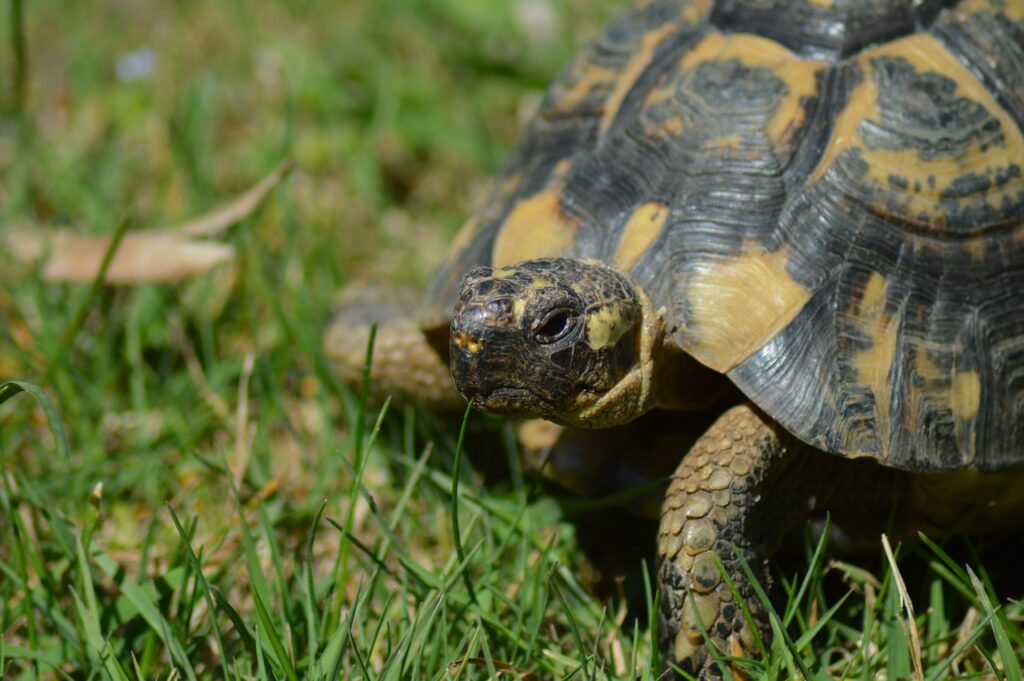
Image: Greek Tortoise Pixabay
Greek tortoises are amazing animals that have attracted the attention of animal lovers around the world. These small reptiles, native to Greece and its surroundings, require a special diet that makes them different from other tortoise species. Knowing what they eat is essential for their wellbeing and health.
Leafy greens, such as dandelion greens, kale, and collard greens, are a must-have in a Greek tortoise’s diet. These vegetables provide essential nutrients like calcium, needed for developing and keeping their shells strong. Plus, leafy greens offer fiber, which helps digestion and prevents certain diseases.
In addition to leafy greens, Greek tortoises also love several different vegetables and fruits. They could enjoy cucumber slices, bell peppers, carrots, and strawberries. Nevertheless, moderation is critical when giving them fruits since they contain natural sugars.
Moreover, providing the right amount of calcium is an important part of their diet. Using calcium powder to dust their food or giving them cuttlebone or reptile-specific calcium blocks is a great way to do this. This extra source of calcium helps with proper bone growth and stops the creation of shell abnormalities.
Reptiles Magazine suggests feeding Greek tortoises a balanced diet composed mostly of leafy greens, supplemented with vegetables and fruits. Offering a varied menu not just keeps them physically fit but also mentally stimulated as they find new tastes and textures every day.
Key Takeaways
- Greek tortoises primarily eat a diet consisting of various plants and vegetation.
- Their diet should include a variety of leafy greens, grasses, flowers, and fruits.
- It is important to avoid feeding them foods that are toxic or harmful to their health.
- Greek tortoises require a balanced diet to ensure proper growth and overall well-being.
- Providing a calcium supplement is crucial for their shell and bone health.
- Feeding them a diet rich in fiber helps maintain their digestive system.
- It is recommended to consult with a veterinarian or reptile specialist for specific dietary guidelines for Greek tortoises.
Background information on Greek tortoises
Testudo graeca, aka Greek tortoises, are a captivating species that have fascinated people for centuries. They have short, sturdy limbs with strong claws, allowing them to dig and move around easily. As cold-blooded creatures, they bask under the sun to regulate their body temperature.
These herbivores feed on grasses, flowers, leaves, and fruits. During mating season, males perform elaborate courtship rituals such as head bobbing and circling behaviors.
In the past, Greek tortoise shells had symbolic and divination value. Today, they are important for seed dispersal and vegetation growth. So, become the Greek tortoise whisperer and give them the lettuce diet they deserve!
Importance of understanding their dietary needs
Gaining an understanding of the dietary requirements of Greek tortoises is key to ensuring their well-being. This knowledge can help provide the nutrients they need and prevent any future health issues.
- 1. Knowing what they eat enables us to create a balanced and nutritious diet for them. This encourages healthy growth and development.
- 2. We can also mimic their natural habitats by offering appropriate food sources. This helps promote a healthier lifestyle.
- And lastly, understanding their dietary preferences helps us identify any potential deficiencies or overconsumption of certain nutrients. By monitoring their food intake, we can address any imbalances quickly.
Furthermore, Greek tortoises have particular food preferences which depend on their age and habitat. Younger tortoises require more protein-rich meals for their growth, whereas older ones prefer a diet consisting of vegetables and plants.
To satisfy the dietary needs of Greek tortoises, consider these tips:
- Provide a variety of leafy greens like kale, dandelion greens, and romaine lettuce. These offer essential vitamins and minerals for their health.
- Include fruits like strawberries and melons as occasional treats. These add flavor diversity and extra hydration.
- Add calcium supplements or cuttlebone pieces to their diet. Calcium is essential for maintaining the strength of their shells.
By following these suggestions, you can make sure your Greek tortoise receives all the nourishment they need. Consulting with an experienced reptile nutritionist can also help you better understand their dietary requirements. Remember, it is important to stick to their natural diet – no souvlaki deliveries!
Basic feeding guidelines

Greek tortoises have specific feeding guidelines that should be followed to ensure their optimal health and well-being. These guidelines can be categorized into four main points:
- Diet: Greek tortoises are primarily herbivorous, so their diet should consist mainly of leafy greens, such as dandelion greens, kale, and collard greens. They can also eat small amounts of fruits, such as strawberries and melons. It is important to provide a variety of food to ensure they receive all the necessary nutrients.
- Calcium: Greek tortoises require a good source of calcium to maintain strong shells and bones. This can be provided through calcium-rich vegetables like broccoli and spinach, as well as calcium supplements specifically formulated for tortoises. It is essential to provide a balanced calcium-to-phosphorus ratio.
- Feeding frequency: Adult Greek tortoises should be fed every other day, while younger tortoises may require daily feedings. It is important not to overfeed them, as obesity can lead to various health issues. Fresh food should be provided each time, and any uneaten food should be promptly removed.
- Water: While Greek tortoises obtain most of their hydration from their food, it is still important to provide a shallow water dish for them to soak in. This helps with hydration and allows them to regulate their body temperature. The water should be changed regularly to maintain cleanliness.
In addition to these basic feeding guidelines, it’s important to note that Greek tortoises have individual preferences and may require adjustments to their diet based on their specific needs and any health conditions they may have. Consulting with a reptile veterinarian can provide valuable insight into tailoring the feeding regimen for your tortoise.
For a real-life example, consider the story of a Greek tortoise named Hercules. His owner diligently followed the basic feeding guidelines and provided a varied diet, ensuring he received ample amounts of calcium. As a result, Hercules grew into a healthy and thriving tortoise, with a strong shell and vibrant colors. This anecdote highlights the significance of adhering to these feeding guidelines for the well-being of Greek tortoises.
By understanding and implementing these basic feeding guidelines, Greek tortoise owners can provide their pets with a balanced and nutritious diet, promoting their overall health and longevity.
Get ready for a shell of a good time as we dive into the world of Greek tortoise cuisine!
Types of food Greek tortoises eat
Greek tortoises need a diverse diet to be healthy. Some things they enjoy eating are:
- fresh greens like dandelion, collard and kale
- herbs like parsley, basil and mint
- edible flowers such as hibiscus and rose petals
- fruits like melon and strawberries, but sparingly
- plus vegetables like carrots, bell peppers and squash
Additionally, they can also have cactus pads and sometimes insects. But avoid feeding them toxic plants or processed human food.
For the best nutrition possible, talk to a veterinarian who specializes in reptile care. This will ensure your Greek tortoise has a healthy and fulfilling life. So veggie-up and make sure your herbivorous buddy is happy!
List of suitable vegetables and fruits
Veggies and fruits are important for a healthy and balanced diet. Get all the essential nutrients, vitamins, and minerals by including a variety of these in your daily meals. Here are some options to consider:
- Leafy greens: Spinach, kale, lettuce
- Cruciferous veggies: Broccoli, cauliflower, cabbage
- Root veggies: Carrots, potatoes, beets
- Citrus fruits: Oranges, lemons, grapefruits
- Berries: Strawberries, blueberries, raspberries
Different veggies and fruits offer different benefits. Leafy greens are high in iron and fiber while citrus fruits are loaded with vitamin C. Include a range of them to promote overall well-being.
Experiment with flavors and textures by adding seasonal produce. Don’t miss out on the benefits fresh veggies and fruits have to offer. Start incorporating them into your diet now for a healthier tomorrow!
List of safe herbs and plants
Safe herbs and plants are a must for our furry friends’ well-being. Here’s a helpful list:
- Mint: Aids digestion, freshens breath.
- Parsley: Adds flavor, promotes kidney health.
- Chamomile: Calms anxiety, helps with sleep.
- Dandelion: A natural diuretic, supports liver function.
- Calendula: Anti-inflammatory, soothes skin.
These herbs and plants also provide essential vitamins, minerals, and antioxidants. Check with your vet before feeding them to your pet.
Don’t miss out on the chance to enhance your pet’s health! Give them the right amount of these safe herbs and plants – your furry friend will thank you!
Quantity and frequency of feeding
Feeding your pet is important for their well-being and health. So, how much and when should you feed them? Here are some tips:
- Pick the right portion size for your pet based on age, size, breed, and activity level.
- Divide the recommended amount into multiple meals throughout the day instead of one meal.
- Puppies: Need more frequent feedings as they have higher energy needs. Aim for 3-4 meals a day.
- Adult dogs: Most adult dogs do best with 2 meals a day. But, may vary depending on their needs.
- Kittens: Have fast-growing bodies and need small, frequent meals. Feed 4-6 times a day.
- Adult cats: Generally do alright with 2 smaller meals or free feeding throughout the day. Ask your vet for specific advice.
Be aware of any unique dietary requirements or medical conditions your pet has. Consult a vet to see if changes need to be made to their feeding schedule or portion sizes.
To make sure your pet is getting proper nutrition:
- Don’t overfeed them. Follow the recommended portion sizes from your vet or food packaging.
- Don’t free feed (leave food out all day) unless advised by a vet.
- If switching to a new diet, introduce gradually over several days.
These tips are general advice. Each pet is unique and may require different needs. Observe your pet’s behavior, appetite, and health to see if adjustments are necessary.
Feeding your pet is key for their daily routine. By following these guidelines, you can ensure they get the nourishment they need to be healthy! Crash diets are tempting, but your body won’t like it in the long run.
Potential health issues related to diet
Potential health issues related to diet in Greek tortoises can have a significant impact on their overall well-being. It is crucial to understand the specific dietary requirements of these tortoises to avoid potential health complications.
- Imbalanced nutrition: Greek tortoises require a diet that consists mainly of leafy greens and weeds. Feeding them a diet high in fruits or protein can lead to imbalances in their nutrition, causing various health issues.
- Vitamin and mineral deficiencies: Inadequate intake of essential vitamins and minerals can result in deficiencies, leading to problems like weakened immune systems, poor shell growth, and reproductive issues.
- Gastrointestinal problems: Greek tortoises are prone to gastrointestinal issues such as bloating and constipation if their diet lacks sufficient fiber. These problems can cause discomfort and even serious health complications if not addressed promptly.
- Dehydration: Providing fresh water is essential for Greek tortoises as dehydration can lead to multiple health problems, including renal dysfunction and organ failure.
- Obesity: Overfeeding and incorrect diet choices can cause obesity in Greek tortoises, leading to joint problems, heart disease, and a decreased lifespan. It is vital to monitor their food intake and provide a balanced diet.
Greek tortoises require careful attention to their dietary needs to ensure a healthy and fulfilling life. Implementing a proper diet plan, along with regular veterinary check-ups, can help prevent these potential health issues.
As an interesting fact, research conducted by the World Turtle Trust has shown that Greek tortoises are highly adaptable and can survive on different vegetation depending on their environment.
Common mistakes to avoid: thinking a Greek tortoise will not eat your favorite pair of shoes but realizing they have a taste for fashionable footwear too.
Common mistakes to avoid
Skipping meals can cause imbalances in nutrient intake and energy crashes. Rely on whole foods instead of processed ones, which often contain unhealthy fats, added sugars, and sodium. Be mindful of portion sizes to prevent overeating. And stay hydrated! Dehydration affects metabolism, digestion, and performance.
Prioritize a healthy diet: plan ahead, read food labels, practice mindful eating, and seek professional guidance. Small changes can make a big difference!
Signs of a healthy diet
A healthy diet can be identified through certain signs. Fruits and veggies of all colors, limited added sugars and processed food, lean protein sources like fish, poultry, or legumes, whole grains instead of refined, and sources of healthy fats are all essential.
Portion sizes matter and mindful eating habits are encouraged. Also, drinking plenty of water and reducing sodium and saturated fats from processed and fried foods.
When cooking, choose organic produce and minimally processed foods to increase nutrient content.
Prioritize whole foods for optimal health and vitamins and minerals. This can help support the body’s natural functions and reduce the risk of chronic diseases like heart disease and type 2 diabetes, according to a study by the American Heart Association (AHA).
Additional tips for keeping Greek tortoises healthy
Caring for Greek tortoises is key for their health. Here are some tips to help them live in the wild:
- Diet: A mix of fresh leafy greens, veggies and fruits is a must. Balance calcium-rich foods with fibrous ones.
- Water: Provide easy access to clean water all the time. Consider periodic soaking to prevent dehydration.
- Habitat: Give them space to explore and bask under UVB lighting. Include hiding spots or sheltered areas.
- Temperature: Have both warm and cool zones in their enclosure. Let them move between the gradients.
- Veterinary check-ups: Visit the vet regularly. Monitor their health, provide necessary vaccines, and address issues before they get serious.
Remember, Greek tortoises can hibernate in colder months. Understand the requirements and methods for hibernation to keep them healthy.
The tradition of keeping Greek tortoises as pets goes back centuries. Ancient Greeks and Romans admired them for their unique look and symbolic significance. Today, people around the world cherish these captivating reptiles as treasured companions. Crazy enough, Greek tortoise diets can be both informing and funny.
Frequently Asked Questions
Q: What do Greek tortoises eat?
A: Greek tortoises primarily consume grasses, weeds, and leafy greens.
Q: Can Greek tortoises eat fruits and vegetables?
A: Yes, Greek tortoises can eat some fruits and vegetables in moderation. However, it is important to avoid feeding them foods that are toxic or harmful to their health.
Q: Do Greek tortoises need a specific diet?
A: Yes, Greek tortoises require a specific diet to stay healthy. Their diet should consist mainly of grasses and leafy greens, with occasional fruits and vegetables.
Q: How often should I feed my Greek tortoise?
A: Greek tortoises should be fed daily, with a variety of foods to ensure they receive all the necessary nutrients. However, portion sizes should be small to prevent overfeeding.
Q: Can Greek tortoises eat commercial tortoise food?
A: While commercial tortoise food can be offered occasionally, it should not be the primary source of nutrition for Greek tortoises. Fresh, natural foods are preferred for their overall health.
Q: Are there any foods that Greek tortoises should not eat?
A: Yes, Greek tortoises should not consume processed human foods, dairy products, meat, or foods high in sugar or fat. These can be harmful to their digestive system and overall health.
Conclusion
Greek tortoises have diverse dietary preferences! They munch on grasses, herbs, flowers, and even cacti. Plus, they love eating fruits like berries and melons for essential vitamins. For extra protein, they sometimes snack on insects and worms. Amazingly, they can eat toxic plants without being affected by the toxins – allowing them to survive in different habitats. When food is scarce, they’ll even feed on dead leaves. But, they’re vulnerable to habitat loss and illegal pet trade. As caretakers, it’s important to respect their environment and help protect them for future generations.
References




